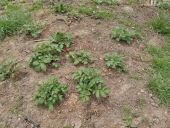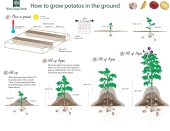

 19
19




Chasing that dream and enjoying every minute of it!
(Usually)
 8
8





 15
15







Be joyful, though you have considered all the facts. ~Wendell Berry
 5
5




Invasive plants are Earth's way of insisting we notice her medicines. Stephen Herrod Buhner
Everyone learns what works by learning what doesn't work. Stephen Herrod Buhner












 6
6




Kim Goodwin wrote:
Your garden looks awesome!
It's very fun to see these things and the garden allows for many close encounters with nature.
Chasing that dream and enjoying every minute of it!
(Usually)












 1
1




Anne Miller wrote:Marty and Kim, thanks for sharing your pictures!
Pictures say what words cannot say.
Beautiful gardens!
I hope other will share their benefits of no-till.
Chasing that dream and enjoying every minute of it!
(Usually)
 10
10




Weeds are just plants with enough surplus will to live to withstand normal levels of gardening!--Alexandra Petri












 4
4




Chasing that dream and enjoying every minute of it!
(Usually)

 13
13
















 6
6




Chasing that dream and enjoying every minute of it!
(Usually)
 4
4




 8
8




Catie George wrote:To me, by far the largest benefit of no till gardening is not having to till.
Yes, lots of benefits, but to me, not having to touch a rototiller dwarfs the rest of them!
Abraham Palma wrote:I was going to say that most of the benefits you all mentioned are not from being no-till, but from mulch protection, policulture and its biodiversity.
Nothing ruins a neighborhood like paved roads and water lines.
 7
7




Forever creating a permaculture paradise!










 6
6




Be joyful, though you have considered all the facts. ~Wendell Berry










 3
3




Be joyful, though you have considered all the facts. ~Wendell Berry












 3
3




Kim Goodwin wrote:Your tomatoes look awesome Marty! Your whole garden does. I love seeing the pictures.
Chasing that dream and enjoying every minute of it!
(Usually)










 4
4




Marty Mitchell wrote:Also, what is that secret heat-tolerant broccoli!?!?! I am just getting into the broccoli game and have been just doing it in the Fall thru mid-Winter and Spring crops.
If I were to be able to do a Summer crop as well... we would not have to freeze as much. Which would free up space for more Fall/Spring crops like potatoes, onions, and garlic. Things we eat like crazy and can't grow enough.
My kale and such always bolt just as soon as we get the super early heat waves in mid Spring. I am hoping the deep mulch I now have applied will turn that around since the soil will be 40F cooler. Know of some hear tolerant kale too??? I have just been growing a "dwarf' cultivar so far... that ends up being 3' wide x 5' tall before it bolts.
Thank you for sharing!
Be joyful, though you have considered all the facts. ~Wendell Berry












 1
1




Kim Goodwin wrote:
If you are willing to try hybrids, or if you just want to see how Johnny's recommends farmers go about providing broccoli all year round, read this chart and growing guide. It's so helpful, very illuminating as to planting times and plant tolerances/needs. It also tells which varieties they sell are the most heat and cold tolerant. And you can obtain those varieties from other places, oftentimes.
Johnny's STANDARD BROCCOLI Planting Program - keys to succession
I believe that Tuscan (Dinosaur) kale is one of the most heat tolerant, as is Portuguese Kale. I like both. Portuguese kale is a short lived perennial, but lives longer if you remove the flowers. It was both cold and heat tolerant in the regions that I've grown it (PNW and desert SW).
Maybe others will share some of the varieties and techniques that have worked for them?
Chasing that dream and enjoying every minute of it!
(Usually)
 1
1














 2
2




Abraham Palma wrote:Yeah, more pics!!!
Kim, as I was reading the explanations... has she said 'chufa'? Maybe in plain English there's a plant with the same name... she can't be possibly making horchata in Oregon, or is it Australia? she mentioned kangaroos... Oh, my, yes it's horchata... It's perfect for a hot summer, but how does she know? ... Also, I thought only people from Valencia were allowed to produce the authentic horchata. I love it flavored with lemon peels and cinnamon, by the way.
Your climate is much harsher than mine and still your garden looks better. In our garden there are three major diificulties: since it's a NGO that distrusts money, we have no money for investments, pretty much everything is a donation or scavenged; because affiliates treat it as a hobby, there's no constancy or responsibilities (even I have just a couple of hours per week for going to the garden); and finally we have little access to water, the town hall gives us 2000 litres every three months, and it takes weeks until refilling, plus whatever rains we have. We even had a drip irrigation system installed and now we've abandoned it. There are plans for installing a roof water catching system, but no one has the skills, the tools, the time and we can't pay for it.
One thing I see in common with heat is that plants are smaller. This year, we've decided to move our efforts towards planting under the cover of established trees and planting more trees. We're now planting dwarf trees in our sunken beds. But it's not the right season yet.
Be joyful, though you have considered all the facts. ~Wendell Berry










 3
3





Be joyful, though you have considered all the facts. ~Wendell Berry
 3
3
















 3
3




Chasing that dream and enjoying every minute of it!
(Usually)
 3
3




Community Building 2.0: ask me about drL, the rotational-mob-grazing format for human interactions.
 2
2




 3
3




 6
6




Elizabeth Blackwood wrote:This is beautiful. I’m really curious about amending soil when using thick layers of wood mulch like this. Do you remove the wood mulch and then add compost etc., and then replace the mulch?

|
Put the moon back where you found it! We need it for tides and poetry and stuff. Like this tiny ad:
Rocket Mass Heater Resources Wiki
https://permies.com/w/rmh-resources
|









